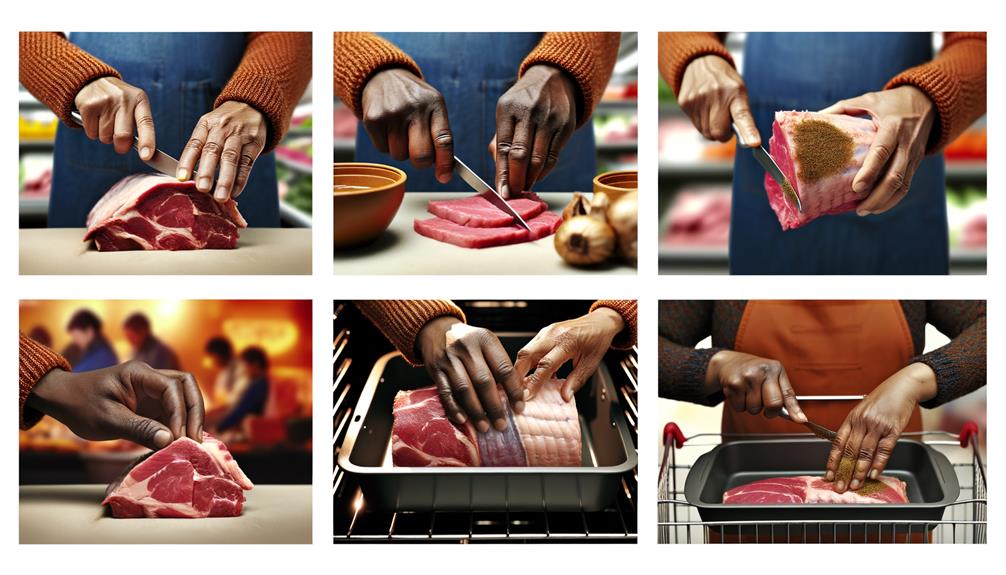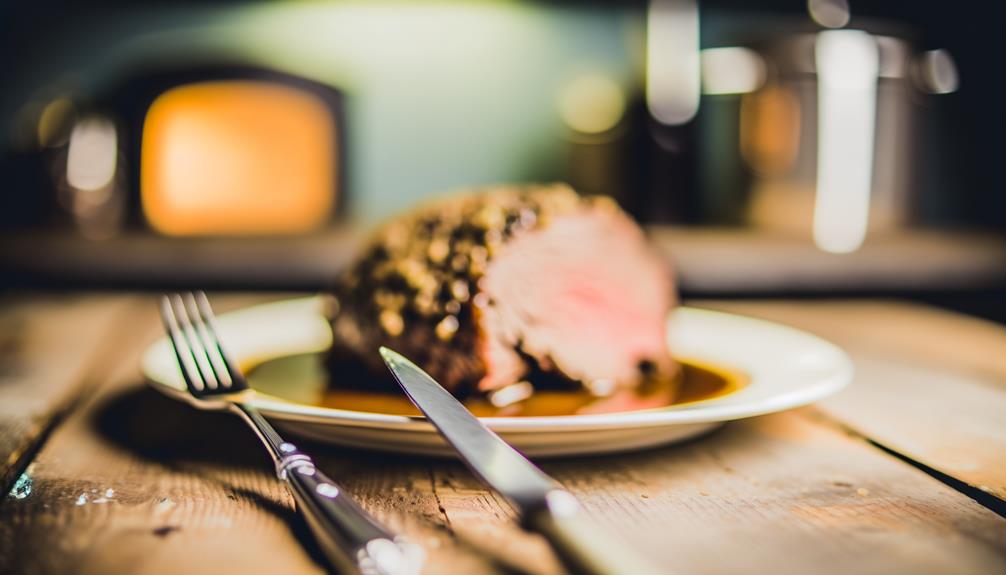To cook a melt-in-your-mouth roast beef, choose a lean cut like top round or bottom round. Preheat your oven to 275F, and sear your beef in butter. This locks in the flavor and juices. Deglaze your pan with beef broth and wine before transferring it to a slow cooker. Use a meat thermometer to cook to an internal temperature of 130F for a medium-rare roast. Remember to allow your beef to rest before slicing, as this allows the juices to redistribute. Following these steps will lead to a succulent roast beef experience. Stick with me, there's more to this culinary journey.
Origins of Roast Beef
Have you ever wondered about the roots of our beloved roast beef, a dish that's been a cornerstone of British cuisine since the 15th century? Roast beef, a richly flavored meat traditionally cooked in an oven or pot, has a storied history that's as tender as its most melt-in-your-mouth recipes.
In the 18th century, roast beef became synonymous with English national identity, a symbol of cultural pride celebrated in literature and art. It wasn't just a Sunday meal served in homes and pubs, it was a representation of the quintessential Englishman. The popularity of this flavorful dish even led to a unique nickname, 'John Bull,' representing the stereotypical Englishman.
So, how did this humble meat dish become so iconic? It's all in the execution: cooking roast beef to perfection, achieving that delicate balance between a tender interior and a flavorful exterior. But more on that later.
In essence, the story of roast beef isn't just about a recipe. It's about the rich tapestry of British culture and identity, woven through centuries. And every time we cook our own Mouth Roast Beef, we're participating in that tradition. Fascinating, isn't it?
Essential Roast Beef Elements
Let's explore the key elements that make a mouthwatering roast beef, starting with the right cut of meat. Lean cuts like top round or bottom round are ideal. Why? They melt in your mouth when cooked right.
Slow cooking is your best friend when it comes to achieving a succulent texture. It tenderizes the beef, ensuring every bite is a delight. But before slow cooking, don't forget to sear the roast. This locks in juices and enhances flavor.
A perfect roast beef is all about hitting the right internal temperature. Aim for 130F for a medium-rare roast, the ideal doneness for a melt-in-your-mouth experience.
To further enhance flavor, play around with ingredients. Red wine, garlic, Worcestershire sauce, and fresh herbs like rosemary work wonders.
Here's a quick table summarizing the essential elements:
| Key Element | Description | Example |
|---|---|---|
| Cut of Meat | Lean cuts are ideal | Top round, bottom round |
| Cooking Method | Slow cooking to tenderize beef | Low temperature, long time |
| Searing | Locks in juices and enhances flavor | Sear before slow cooking |
| Internal Temperature | Aim for 130F | Medium-rare roast |
| Flavor Enhancers | Use ingredients to enhance flavor | Red wine, garlic, Worcestershire sauce, rosemary |
Roast Beef Preparation Steps

To create that perfect melt-in-your-mouth roast beef, start by selecting a lean cut like top round or bottom round. The choice of cut is essential in achieving a tender roast beef recipe. As a fan of roast beef sandwiches, I can vouch for the difference a good cut makes.
To prepare the roast:
- Preheat the oven to 275F. Sear all sides of the beef in butter on high heat to lock in the juices. The oven roast technique gives a delightful crust to the beef.
- Deglaze the pan with beef broth and some wine, then transfer the roast to a slow cooker. Slow cooker roast beef is a foolproof method to achieve succulent, tender meat.
- Use a meat thermometer to check the internal temperature. For a medium-rare roast, aim for 130F. Remember to rest the beef before slicing.
Pair your roast with side dishes such as green beans, mashed potatoes, or cauliflower mash. These accompaniments elevate the roast to a complete, satisfying meal. Cooking is all about experimentation, so feel free to tweak the recipe to your taste. Enjoy your melt-in-your-mouth roast!
Expert Tips
Now, let's move on to some expert tips that will elevate your roast beef game.
We'll first talk about how to select the highest quality beef for your roast.
Then, we'll discuss the right way to prepare it, and finally, share some secrets on how to keep your roast beef moist and tender.
Choosing Quality Beef
When it comes to cooking delicious roast beef, selecting a well-marbled cut like chuck roast or ribeye roast is a great choice. The marbling gives the roast its mouthwatering tenderness and flavor. While shopping, I look for USDA Prime or Choice grades. These labels guarantee higher marbling and tenderness, indicating top quality beef.
Grass-fed beef tends to have a healthier fat profile and more flavor. I also inspect the beef color. Fresh, quality beef should be a vibrant red color with minimal fat on the edges. To wrap up, I confirm freshness by giving the beef a quick sniff. It should have a fresh, meaty smell and it shouldn't be discolored or slimy. Remember, the better the beef, the better the roast.
Roast Beef Preparation
Often, I start my roast beef preparation by choosing the right cut, such as eye of round, top round, bottom round, chuck roast, or shoulder roast for the most tender and flavorful results. Using a sharp knife, I make slits in the roast and stuff them with garlic, salt, and pepper. I let it sit at room temperature for a couple of hours before I start the slow method of roasting in a roasting pan.
A favorite pot roast recipe of mine involves searing the roast, then adding in cream of mushroom soup, onion soup mix, and a sprinkle of red pepper flakes. Fresh rosemary adds a lovely touch before I slow roast it all to perfection. The result? An irresistibly tender roast beef with gravy that truly melts in the mouth.
Maintaining Beef Moisture
To keep your roast beef juicy and full of flavor, it's essential to use a meat thermometer, guaranteeing the beef is cooked to the correct internal temperature. This is the first step towards beef moisture retention.
While cooking, I always baste the beef with pan juices or a flavorful broth. This not only adds flavor but also helps in keeping the meat moist.
After the beef is cooked, avoid cutting it immediately. Instead, let it rest for a while; this resting time allows the juices to redistribute, enhancing the flavor and moisture.
To further aid moisture retention, I suggest tenting the beef with foil as it rests. Trust me, following these tips will ensure that your roast beef is always moist and flavorful.
Final Thoughts
In conclusion, there's nothing quite like the satisfaction of biting into a tender, flavorful roast beef that's been slow-cooked to perfection. The secret to this culinary delight lies in the slow cooking of a well-marbled chuck roast in a trusty crockpot. The marbling adds to the juiciness, making each bite melt in your mouth.
Adding a can of mushroom soup, coupled with onion soup mix, does wonders for the flavor profile. The layers of taste the soup imparts to the beef is nothing short of amazing. Meanwhile, the initial searing of the beef locks in the juices and forms a delicious crust.
Serving the roast with classic sides like mashed potatoes and a variety of vegetables not only completes the meal but also complements the beef's rich flavors. The creamy potatoes and the crisp vegetables provide textural contrast and lighten the hearty beef.
In the end, the satisfaction comes not only from the delectable meal you've prepared but also from the knowledge that your carefully chosen ingredients and method have brought out the best in your roast beef. That's the beauty of cooking.
